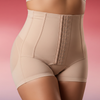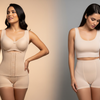Healing with Comfort: Shapewear After Surgery

Learn why it is important to use comfortable shapewear after surgery. Here we have some tips for you in order to choose compression garments for healing.
If you are reading this post, it is because you are considering surgery and want to ensure that you´ll have a satisfactory healing process. Sometimes, we think of a surgery as a painful experience that is going to put us through a huge number of limitations, but it does not necessarily have to be like that. It is true we need to be careful with some things, but if you prepare yourself and select the correct recovery-friendly shapewear this healing process will be comfortable and joyful. In this post, we are going to show you how to achieve that.
The first thing to take into account is the kind of surgery. Not all the fajas cause the same effect. The faja that is useful for the first week after surgery may not be the best option to wear on day 30. Also, the faja used after a tummy tuck is not the most suitable garment for a postpartum recovery. This can be confusing, but after reading this article it will be a piece of cake. In this post we are going to center on plastic surgeries, but we will dive deep into postpartum recovery in further posts. Let's go back to the plastic surgeries. It is very common that when someone is going to pass through a surgical procedure, the surgeon recommends using recovery-enhancing compression wear. Well, there are some things you need to consider in order to choose the correct faja. Some of them are: the kind of plastic surgery (tummy tuck, BBL, breast augmentation…), the recovery stage, your type of body, experience using fajas, allergies, weather and budget.
The type of surgery:
Let's begin with the type of surgery. It is important to understand each procedure has its own healing requirements. In general terms, surgical recovery garments aim to reduce inflammation, avoid deformities, liquid retention and heal the wounds. That is why it is so convenient to wear compression garments for surgical healing. But depending on the surgery we will need more or less compression in some parts of the body. Let's talk about the details of some of them.
Abdominoplasty:
Also known as Tummy Tuck, this procedure consists of a horizontal incision between your belly button and pubic zone. This is done to remove the excess skin and fat from the abdomen. In this case, the supportive post-surgery shapewear should have special compression in the ab zone. In order to healing with compression clothing is suggested to use these garments every day for six months after the surgery.
Liposuction:
This surgery is similar to the previous one, but in this case, it can be applied to other parts of the body such as the buttocks, double chin, arms, or neck. Sometimes, the removed fat can be relocated to another part that needs it. When we suggest a faja for the liposuction, it will change according to the zone of the surgery. But, it is important to consider that the parts where the fat was extracted need more compression, the parts where the fat was relocated must not have compression.
Brazilian Butt Lift:
In this surgery the key concept is to relocate fat. Specifically, extract the fat from abs, thighs or upper leg to insert it in the buttocks. As the BBL is a procedure whose objective is to relocate fat, the shapewear for postoperative support needs to make compression in the thighs and abs but giving space to the butt. As we said previously, post-surgery shapewear should not make compression In the parts where the fat was introduced.
The recovery stage:
Once you have a successful surgery, the next step is recovery. The days after a procedure are critical. Those are the days when you need to be more careful with your wounds. The 15-20 days after surgery are known as Stage I. In this stage you need a medium level of compression. When you reach 20 days after surgery (stage II) it is good to increase the compression, so at this moment the post-surgery shapewear needs a high level of compression. The stage III (3 months post-surgery) is the period when you begin to use super high compression. It is important to keep using the surgical body shaping solutions if you want to keep the achievements. Usually, the faja is recommended to use until 6-8 months after surgery, but this period can change according to the surgeon. After the eighth month, you can start to use other kinds of fajas made for daily use.
Body Types:
All of the procedures we have mentioned before are going to change your body. It is probable that your type of body changes after the surgery, so you need to consider that if you want to pick the best shapewear for post-op recovery. Typically, there are five types of body: apple, triangle, inverted triangle, hourglass and rectangle.
Apple:
In this type of body the bust is larger than the rest of the body. The midsection is wide and the hips are small compared to the upper zone. For these women we suggest fajas that give support to the waist and abs. Fajas with hook and eye closure are better for this type of compression but you can also use zipper fajas. Also, we suggest using the waist as a baseline measurement in order to choose the size of the garment.
Triangle:
Also known as “pear”, this body has wider hips and narrow bust. The waist is not clearly accentuated. As the hips are the larger section of the body, we do not recommend bodysuits or shapewear with short legs. It is better to use mid-thigh, knee length or capri length. We suggest using the hips as the baseline measurement.
Inverted triangle:
This body has thin hips and a subtle waist. The shoulders and bust are wider in comparison to the rest of the body. That is why we need to take into account the fat around the armpits, high back and bust. In this case, we do not suggest wearing strapless or lower back fajas. Baseline measure: waist.
Hourglass:
In this type of body the bust and hips are proportional and well balanced, the waist is clearly defined. To these women we suggest fajas with mid or high backs and with medium or large legs. Also it is important that the garment gives enough compression in the waist and abs aiming to highlight the natural shape. You should take your hips as a baseline measurement.
Rectangle:
All your measures are similar. This type of body does not have almost any restriction in terms of fajas. It will depend on your specific goals. It is common to wear a faja that compresses the lower abs and contours the waist. Baseline Measurement: waist or hips (the larger one).
Level of experience using fajas:
If you want to achieve the best body shaping after surgery, you need to pay attention not only to your body type and type of surgery but also to your experience using this kind of garments. There are many options of post-surgical compression wear, but if you have never used a faja you will want less compression at least in the first days after the surgery so your body gets used to the garment.
Expert level:
Let's say you are used to the compression wear and use it more than eight hours a day. In this case you need high compression because your body feels comfy using fajas. It will not be hard for you to use post-surgery body contouring garments.
Medium level:
You use fajas for less than eight hours a day, so you have experience using fajas but you should try a medium level of compression if you want to take advantage of the healing benefits of post-surgery shapewear.
Beginner level:
You have barely experience using fajas. In this case you should try a low level of compression. Not just because your body needs to get used to this kind of garment but also because you are facing a healing process.
Types of materials:
There are a lot of surgical recovery shapewear options you can try. One of the main features of these garments is the material. We will review here some of the most common of them.
Powernet:
This is an elastic material made with a mix of polyamide and elastane. Powernet garments are very adjustable to the body. Usually, these garments are covered inside with cotton or nylon to avoid irritations in the skin. High-compression garments are often made of Powernet.
Triconet:
This is also an elastic material whose main features are its brightness and its bidirectional fabric. It is common to find it covered with cotton but also without it. It is considered a material with a medium level of compression, which makes it a great option for beginners who want comfortable compression clothing after surgery. The sensation that Triconet produces at the contact with the body is similar to Lycra or Spandex, so you will not feel a big difference between the garment and your outfit.
Latex:
Latex is one of the most durable and elastic materials ever created. It is composed of wax and gum extracted from rubber trees. It is very common in sports garments, but you need to be assured you are not allergic to this material.
Spandex:
Spandex is also one of the most used materials in the textile industry. This is because of its elasticity. It can be stretched 600x and come back to its original shape. Also it has a great endurance and it can be dry cleaned. You can find a lot of fajas with low compression made of this material.
Budget:
Another aspect at the moment of choosing shapewear for surgical aftercare is the price. We can find fajas from $20.00 USD to $125.00 USD, this will depend on things such as the materials and the brands.
Weather:
As any other garment, the weather will affect your experience using fajas. If you live in a place with warm weather you will want to acquire a faja made with fresh materials like Powernet or Triconet.
Allergies:
Some people need to pay close attention to the material of the faja, because some materials can produce allergic reactions in delicate skins.
In this post we have discussed some of the things you need to consider at the moment of using shapewear for postoperative comfort.
Plastic surgery is an important decision in your life, so you need to care about your healing. As we said previously, you must take into account the kind of procedure you are going to face. This will allow you to pick compression shapewear that contours your body in the right way. Remember that in the surgeries that relocate the fat (BBL, liposuction…), the garments must apply pressure in those parts where the fat was removed and give space to those places where the fat was inserted. Also it is good to have in mind your type of body. This will not only make you feel more comfortable but also will allow you to achieve the best results in your healing. In addition, the stage of your recovery also determines the faja that you are going to wear. The more advanced the stage of your recovery, the more compression you should add to your garments. Don´t forget to pick a faja according to your experience using compression wear. The healing process is the priority, and you should keep it comfortable. Please, do not try to use high compression garments if you have never used a faja, begin with a garment with low compression. Be very careful of the type of material, there are some of them that can give you a better experience due to its resistance and freshness. Also make sure you are not allergic to any of these materials.
Finally, do not be shy, contact us, we will be happy to help you to shape your story.








